How to Help My Dog Stop Panting

Have you ever seen your pup panting heavily after a walk or when it's hot? As a dog owner, a panting dog can be concerning, but don't worry!
Our furry friends may sometimes get stressed, anxious, or overheated, leading to excessive panting. As a pet owner, you need to know how to recognize when your dog is panting excessively and how to calm a panting dog.
In this article, we’ll learn how to calm down a dog’s breathing.
Need professional advice? Install the our app to ask for help from a Woofz dog assistant to dive deep into the problem and get instructions to follow.
How To Calm A Panting Dog: 11 Professional Methods
Frequent heavy dog breathing can be worrying. Many pet owners ask themselves: why do dogs pant so much? A dog or a puppy panting a lot is a standard way for canines to regulate their body temperature and breathe more easily.
However, excessive or abnormal panting can signal your dog is anxious, stressed, or overheated. Let’s discuss how to calm a panting dog if your dog is panting excessively to help them feel more relaxed.
1. Provide Fresh Water
If your dog is breathing hard, ensure they have lots of water to keep them hydrated. Panting causes your pet to lose water from their body. So, replenishing their water reserves is essential.
In hot weather, be extra careful when it comes to dehydration. Watch out for potential signs, like dry, sticky gums. You may also check your dog’s nose to see if it isn’t too dry. If you suspect panting is resulting from dehydration, offer your dog water immediately.
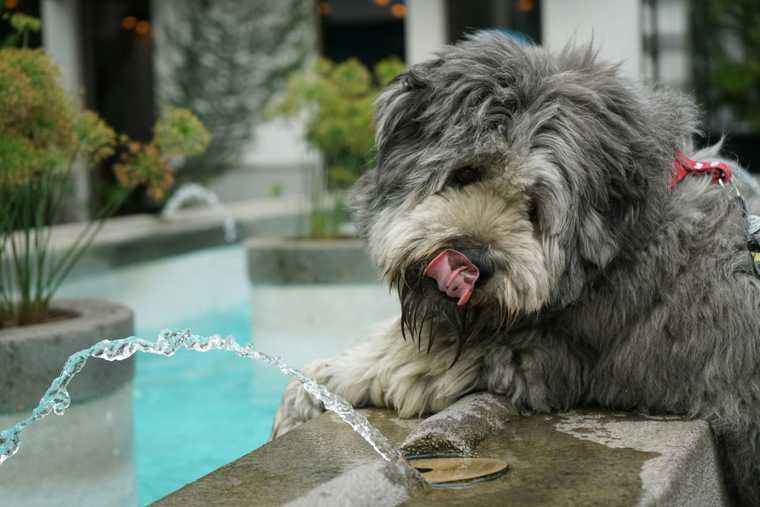
Here are some tips on keeping your dog hydrated:
- Refresh the water in your dog’s bowl with cool water.
- Bring a water bottle with you if you plan to have a long walk in hot temperatures.
- Put in some ice to help them bring down their body temperature faster.
- You can make ice treats with their favorite flavors for hydration and fun.
2. Take Your Dog to a Cool Environment
Sometimes, drinking water isn’t enough to cool down a dog and calm down their breathing. If your dog keeps panting after you offer them water, move your dog to a cooler area. This will help stop excessive panting caused by overheating.
To cool down your dog’s body temperature:
- If you’re outside, find a shady spot.
- If you’re inside, turning on the air-conditioning is perfect.
- You may also give your dog a cooling mat that offers relief.
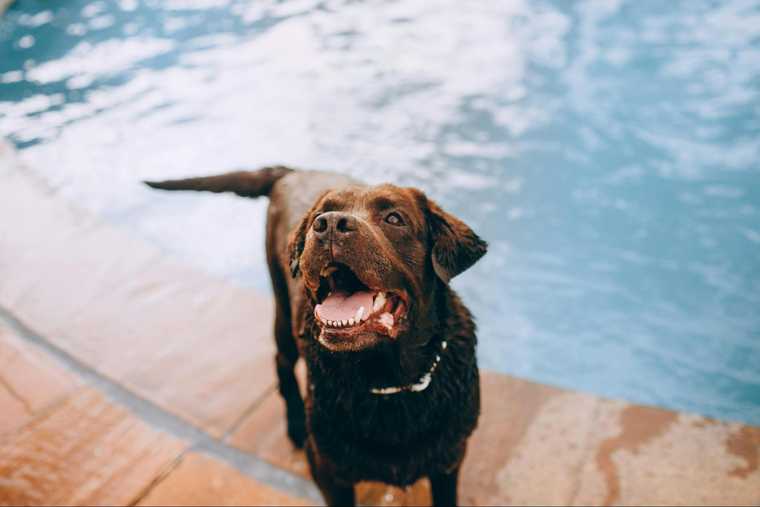
3. Give Your Dog a Safe Space
Anxiety is one of the common reasons why dogs pant. Ideally, you should identify the cause of stress in your dog to tackle the situation effectively. We suggest checking the environment the dog pants in for any anxiety triggers.
If strangers or other pets are around, causing stress to the dog, take them somewhere else so your dog can be alone for a while. In addition, some dogs can get scared of loud noises, such as thunderstorms or fireworks. So, try not to speak loudly and whisper calmly to help your dog unwind.
4. Massage Your Dog
If taking a dog to a noise-free space doesn’t work, you can try helping your canine companion with gentle body manipulations. Thus, a soft massage can be effective for calming a nervous dog. Start slowly by stroking the dog’s ears, chest, and back. Ensure your dog likes the process and keep your movements soft but determined.
For most dogs, such physical contact has a calming and relaxing effect. This is due to the release of endorphins that naturally calm and comfort your dog.
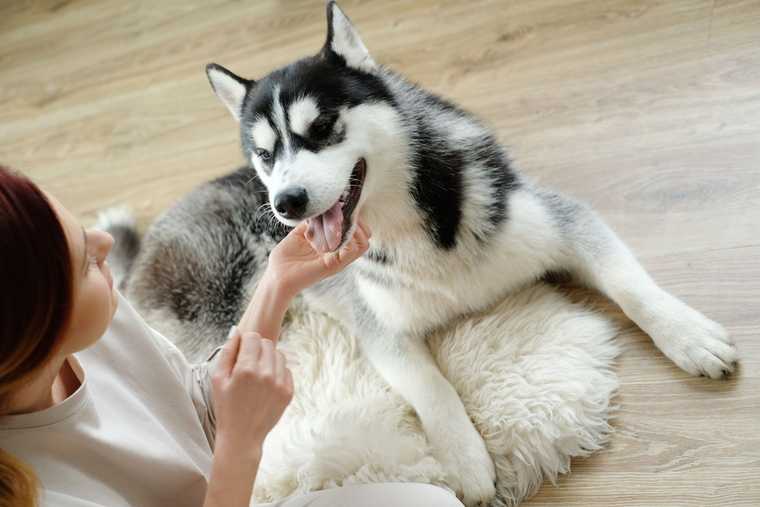
5. Play Relaxing Music
If you’re wondering how to get a dog to stop panting, you may turn to the calming effect of music. It’s not only humans and dogs that can benefit from the relaxing effect of music. Listening to musical pieces takes dogs on a sensory journey, which can soothe them and reduce panting. However, the type of music you introduce your dog to matters.
Put on some soft, calming music to help relax your dog. Music, especially classical music, with a slow tempo, helps to calm dogs. You can find special calming music for dogs on music streaming services, such as YouTube, or you can just use the Wellbeing section in the Woofz app to find relaxing music for your pup.

6. Practice Relaxation Exercises
Relaxation training teaches your dog to channel their energy and control their impulses better. From early on, you can introduce your dog to commands like ‘settle’ or ‘relax’ to help them calm down on cue. Such training can help your dog ignore distractions if taught correctly and methodically.
How can this help excessive panting? If your dog pants due to stress during outings, relaxation exercises provide them with coping mechanisms to reduce stress levels.
7. Provide Mental Stimulation
Mental stimulation keeps your dog entertained and lowers their hyperactiveness and aggression levels. It’s a key to improving your dog's social interactions, which can lead to stress and anxiety in dogs. If fear is the main reason your pet gets stressed out and pants, mentally stimulating activities can fix the problem.
Offer your dog puzzle toys, interactive games, or training exercises. You can also incorporate mental stimulation strategies into your daily routine. For example, take your dog for a walk in new places to make them explore the area. This can help distract them from their panting and relieve boredom or anxiety.
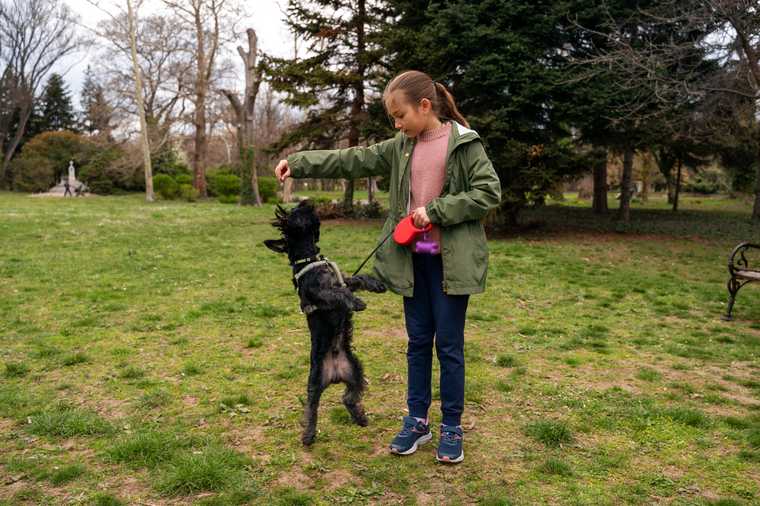
8. Use Calming Products
If the natural remedy for dog panting mentioned above doesn’t help, you can try dog-calming products. Various calming products are available for dogs, such as calming vests, pheromone diffusers, and herbal supplements. Though the data about the effectiveness of these products is inconclusive, some are very popular among dog owners. Certain supplements and devices help reduce anxiety and promote relaxation in dogs.
However, don’t start using the products before consulting your vet. Since some ingredients can harm your dog’s health, getting a professional opinion is always better. Your vet can also determine the reason for the anxiety, such as physical discomfort, to manage the issue more efficiently.
9. Exercise Your Dog Regularly
Lack of exercise or pent-up energy can lead to anxiety, stress, and excessive panting in dogs. Walk your dog daily to burn energy and provide mental stimulus. 15-20 minutes of daily activity is sufficient.
You can also get more creative and engage your dog in physically challenging yet exciting activities. Popular choices are the game of fetch and tug-of-war. Regular physical exercises will improve your dog’s mood and reduce a dog’s panting.
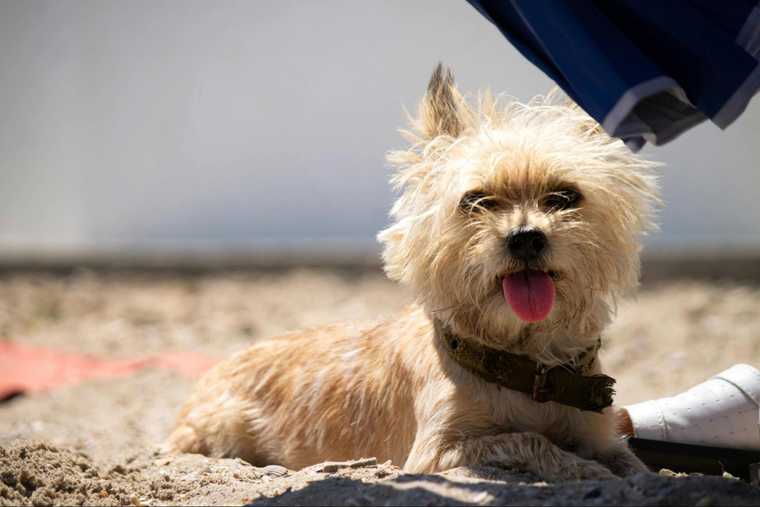
10. Remain Calm
Owners must remain calm and relaxed when dogs pant so as not to trigger pups. Dogs have a great sense of human emotions and will feel your stress or fear. Breathe deeply to maintain your stillness, and speak softly and comfortingly. Your stability will make your dog relax.
Through patience and practice of these techniques, you will learn to notice the signs of anxiety in your dog and react by helping them remain calm and relaxed. Self-control is one of the best ways to calm a dog that is panting with anxiety.
11. Consult a Vet
Sometimes, the cause for a dog panting a lot isn’t clear. You should consult a vet immediately for a checkup if you think it’s excessive. This way, your vet can examine your dog and determine if there are any medical reasons for the dog breathing fast. Veterinary medicine helps exclude medical issues before attributing the panting to anxiety or the environment.
Disrupted breathing in dogs can appear due to a fear of something, insufficient exercise or mental stimulation, spending too much time in isolation, separation anxiety, or other behavioral issues.
If the root cause isn’t dealt with properly, your pet can continue to show anxious behaviors even when you try to calm them down.
When to Seek Emergency Care for Excessive Dog Panting
Does your dog seem to be panting constantly? While healthy dogs pant, too, excessive panting can indicate an underlying health issue and requires immediate veterinary attention.
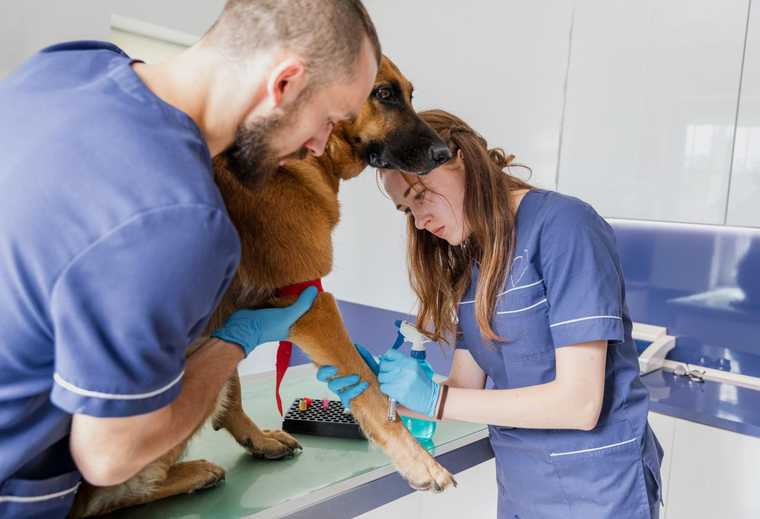
Heatstroke
When your dog’s panting is associated with such symptoms as excessive drooling, extremely red gums, vomiting, or diarrhea, it can be a sign of heatstroke, which is a life-threatening condition. Take your pet to an air-conditioned place and use cool and wet towels to help reduce their body temperature until you can take them to the vet.
Heart or Respiratory Problems
Excessive panting in dogs can also indicate a heart or respiratory problem. If your dog appears to be panting for no reason, has a pale or bluish tint to the gums, or is coughing, the best option is to take them to the vet for examination as soon as possible.
Pain or Stress
Dogs sometimes pant too much because of pain, anxiety, or stress. Excessive panting in dogs can result from recent changes in the dog's environment, schedule, or diet or if the dog is in pain when touched or moving. Attempt to make your dog comfortable and relaxed, and see your vet if panting lasts more than a day.
Wrap-Up
Panting is a natural way of temperature regulation in dogs, but too much panting is usually a sign of distress, anxiety, or an underlying health condition. Pet owners should know dog stress panting signs and how to calm the dog down. Always watch your dog’s panting and see a vet if needed.
The health and condition of your canine companion should always be a top priority.

Passionate team dedicated to help pet owners raise safe and obedient dogs, fostering meaningful connections with their furry companions.

Certified dog trainer, exclusive positive reinforcement methods & tackling aggression problems.